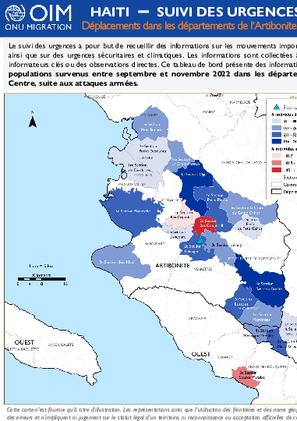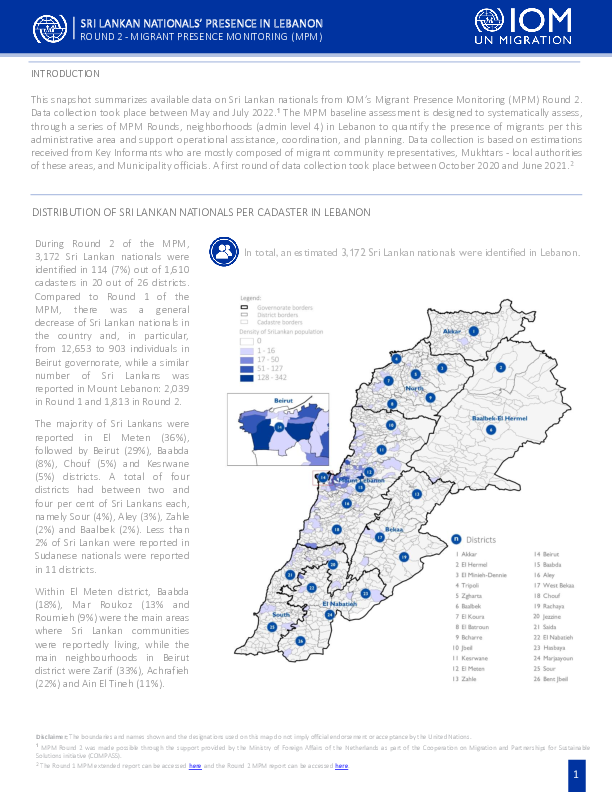-
Countries
-
Data and Analysis
-
Special Focus
-
Crisis Responses

Contact
DTM Nigeria, AllUsersInDTMNigeria@iom.int
Language
English
Location
Nigeria
Period Covered
Nov 28 2022
Dec 04 2022
Activity
- Mobility Tracking
- Event Tracking
The DTM Emergency Tracking Tool (ETT) is deployed to track and to collect information on large and sudden population movements, provide frequent updates on the scale of displacement and quantify the affected population when needed. As a sub-component of the Mobility Tracking methodology in Nigeria, ETT utilises direct observation and a broad network of key informants to capture best estimates of the affected population per location, enabling targeted humanitarian response planning.
Between 28 November and 04 December 2022, a total of 1,424 new arrivals were recorded in locations in Adamawa and Borno States. The new arrivals were recorded at locations in Askira/Uba, Bama, Dikwa, Gwoza, Monguno and Kala Balge Local Government Areas (LGAs) of the most conflict-affected state of Borno and in Fufore, Gombi, Hong, Maiha, Michika, Mubi South, Mubi North, Lamurde, Yola North and Yola South LGAs of Adamawa State.

Contact
DTM Nigeria, AllUsersInDTMNigeria@iom.int
Language
English
Location
Nigeria
Period Covered
Nov 28 2022
Dec 04 2022
Activity
- Mobility Tracking
- Event Tracking
On 04 December, armed bandits reportedly attacked the community Karare in Karare ward of Batsari LGA in Katsina State. The attack affected 398 individuals, who remianed in the community. As a result of the attack, one fatality and 43 injuries were reported.
On 21 November, armed bandits reportedly attacked the community Gidan Goga in Gidan Goga ward of Maradun LGA in Zamfara State. The attack affected 2,810 individuals and displaced 2,808 individuals to the community Sarki Baura/Sarki Mafara in Kaura Namoda LGA. As a result of the attack, 2 fatalities and 5 injuries were reported.

Contact
DTM Nigeria, AllUsersInDTMNigeria@iom.int
Language
English
Location
Nigeria
Period Covered
Nov 14 2022
Nov 20 2022
Activity
- Mobility Tracking
- Event Tracking
On 14 November, a clash between herders and farmers was reported in the Zaki Biam community of Uyam ward in Ukum LGA, Benue State. The attack affected 45 individuals who currently are given shelter by neighbours within the community. As a result of the attack, 1 fatality and 6 injuries were reported.
On 15 November, a clash between herders and farmers was reported in the Mai Katako community of Butura ward in Bokkos LGA, Plateau State. The attack affected 756 individuals, who remained in the community. As a result of the attack, 12 fatalities and 7 injuries were reported.
On 17 November in Benue State, a dispute over land and border issues resulted in a clash between the Bonta community in Mbagusa/Mbatser ward, Konshisha LGA and the Ainu-Ete community in Ukpa/Ainu-Ette ward of Oju LGA. The clash affected 11 individuals. No displacement was reported following this confrontation. As a result of the clash, 2 fatalities and 2 injuries were reported.
On 19 November, a fire outbreak was reported in the community Sabon Layi in Wakilin Gabas II ward of Katsina LGA in Katsina State. The fire outbreak affected 28 individuals, who are currently in neighbouring shelters. The fire outbreak damaged a total of 9 shelters, of which 3 shelters are completely damaged and 6 shelter are partially damaged.
This document is a compilation of data collected by IOM from Frontex as well as the Italian, Spanish, Greek and Maltese interior ministries on migratory movements from Africa to Europe between 2017 and 2022.
IOM works closely with a wide range of actors, including government and non-government partners, to collect and compile this data on a quarterly basis. This document presents the situation of migrant arrivals in Europe based on data for 2021 from the point of view of movements from West and Central Africa (WCA).
* Data for 2022 covers the period up to September 30, 2022 (January - September 2022). These data will be regularly updated in future publications.

Contact
DTM Turkey, dtmturkey@iom.int
Language
English
Location
Republic of Türkiye
Period Covered
Nov 01 2022
Nov 30 2022
Activity
- Flow Monitoring
- Migrants presence
- Mobility Tracking
According to the latest available figures from the Turkish Presidency of Migration Management (PMM), there are more than 4.9* million foreign nationals present in Turkish territory, 3.6* million of whom are seeking international protection. Most are Syrians (3,570,234* individuals) who are granted temporary protection status. In addition, international protection applicants from countries including Afghanistan, the Islamic Republic of Iran and Iraq constitute another group of foreign nationals. According to
PMM, there were 29,256* international protection applicants present in Türkiye in 20211, published annually. Moreover, according to UNHCR**, there are close to 330,000 international protection status holders and asylum-seekers. The number of foreign nationals has decreased by 168,604 in comparison to November 2021 (3.7 million foreign nationals).
In addition, there are 1,345,488* foreign nationals present in Türkiye holding residency permits, including humanitarian residency holders. Compared to November 2021, this is an increase of 69,747 individuals. The exact number of humanitarian residency holders is unknown, but it is estimated that there are more than several thousand humanitarian residency permit holders.
*Data source PMM, 01.12.2022
**Data source UNHCR, July 2022

Contact
DTM Turkey, dtmturkey@iom.int
Language
English
Location
Republic of Türkiye
Period Covered
Nov 01 2022
Nov 30 2022
Activity
- Flow Monitoring
- Migrants presence
- Mobility Tracking
According to the latest available figures from the Turkish Presidency of Migration Management (PMM), there are more than 4.9* million foreign nationals present in Turkish territory, 3.6* million of whom are seeking international protection.
Most of those seeking international protection are Syrians (3,570,234* individuals) who are granted the temporary protection status in Türkiye. In addition, international protection applicants are most frequently nationals of Afghanistan, the Islamic Republic of Iran and Iraq constitute another group of foreign nationals. According to PMM, there were 29,256* international protection
applicants present in Türkiye in 20211, published annually. Moreover, according to UNHCR**, there are close to 330,000 international protection status holders and asylum-seekers.
In addition, there are 1,345,488* foreign nationals under residence permit holder status; this number includes humanitarian residence holders.
*Data Source PMM, 01.12.2022
**Data source UNHCR, July 2022

Contact
DTM Nigeria, AllUsersInDTMNigeria@iom.int
Language
English
Location
Nigeria
Period Covered
Oct 01 2022
Oct 31 2022
Activity
- Mobility Tracking
- Baseline Assessment
- Points of Entry (PoE)
During the COVID-19 pandemic, IOM's Displacement Tracking Matrix (DTM), in collaboration with the World Health Organization (WHO), monitors cross-border movements to and from Nigeria's Borno State in north-east Nigeria. Assessments are conducted at Points of Entry located along the border with Cameroon.
A range of data was collected during the assessments to better inform on travellers’ nationalities, sex, reasons for moving, mode of transportation and timeline of movement as shown in figures 2 to 5 on the dashboard.

Contact
dtmhaiti@iom.int
Language
French
Location
Haiti
Period Covered
Dec 02 2022
Dec 06 2022
Activity
- Event Tracking
Le suivi des urgences a pour but de recueillir des informations sur les mouvements importants et soudains de populations,
ainsi que sur des urgences sécuritaires et climatiques Les informations sont collectées à travers des entretiens avec des
informateurs clés ou des observations directes Ce tableau de bord présente des informations sur des déplacements des
populations survenus entre septembre et novembre 2022 dans les départements de l’Artibonite et du Centre, suite aux attaques armées.

Contact
iombeirut@iom.int
Language
English
Location
Lebanon
Period Covered
May 01 2022
Jul 31 2022
Activity
- Flow Monitoring
- Mobility Tracking
- Baseline Assessment
This snapshot summarizes available data on Sri Lankan nationals from IOM’s Migrant Presence Monitoring (MPM) Round 2. Data collection took place between May and July 2022. The MPM baseline assessment is designed to systematically assess, through a series of MPM Rounds, neighborhoods (admin level 4) in Lebanon to quantify the presence of migrants per this administrative area and support operational assistance, coordination, and planning. Data collection is based on estimations received from Key Informants who are mostly composed of migrant community representatives, Mukhtars - local authorities of these areas, and Municipality officials. A first round of data collection took place between October 2020 and June 2021.


